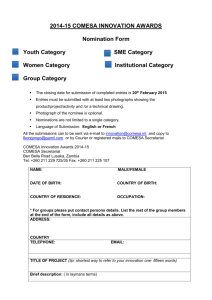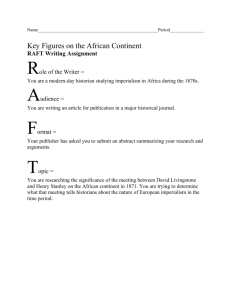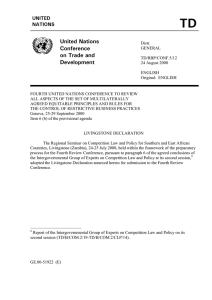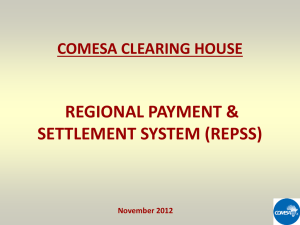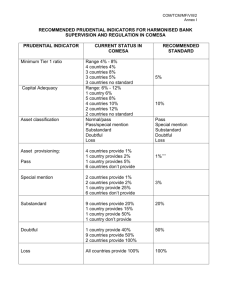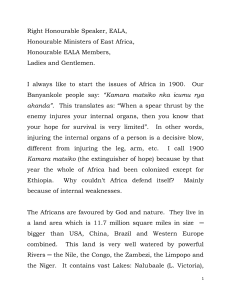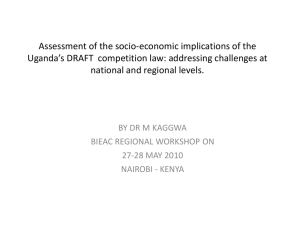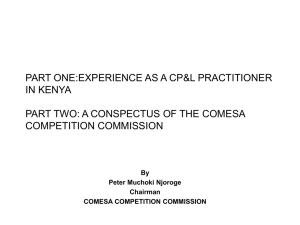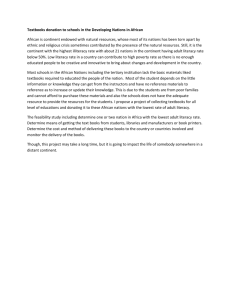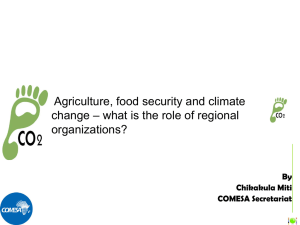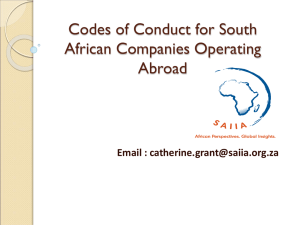comesaspeech1 - State House Uganda
advertisement
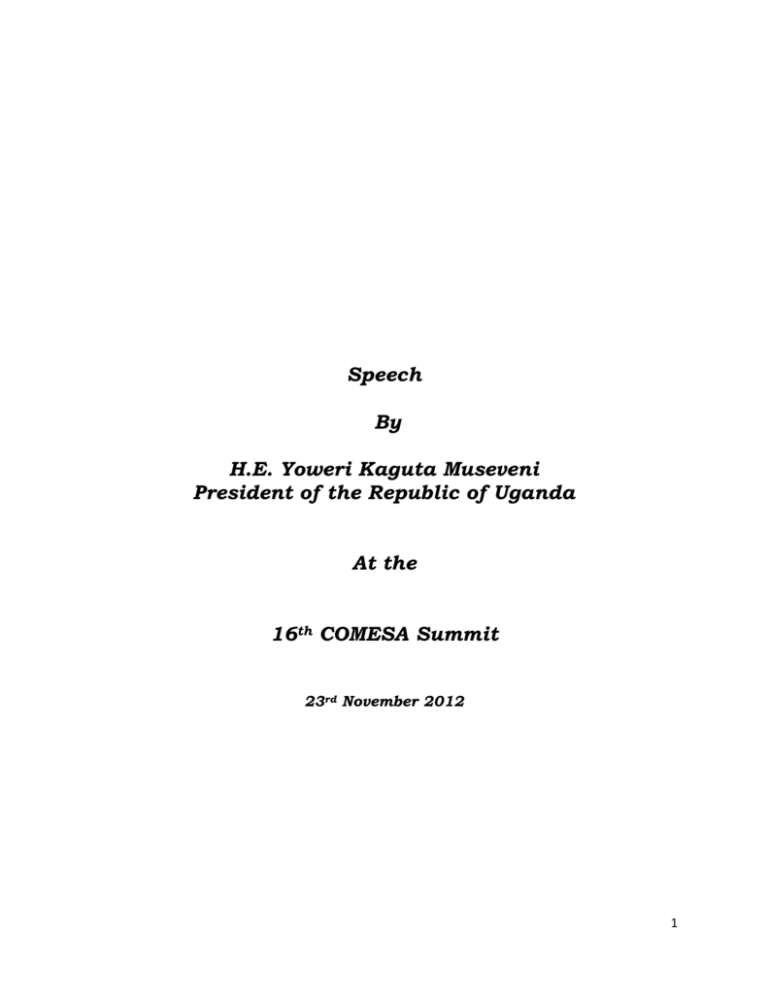
Speech By H.E. Yoweri Kaguta Museveni President of the Republic of Uganda At the 16th COMESA Summit 23rd November 2012 1 Your Excellencies, Heads of State and Government, Heads of delegations, Distinguished guests, Ladies and Gentlemen. I greet you and I welcome you to Uganda for this 16th COMESA Summit. The greatest disadvantage Africa faced at independence, ever since 1957, when Ghana got independence, was political balkanization of this continent. The North American Continent has got only three countries ― USA, Canada and Mexico. The South American continent has got 15 countries including the Central American Isthmus 2 and the three dependencies of Falkland Islands, French Guiana, South Georgia and the South Sandwich Islands. The Australian continent has got one country, Australia. The Indian sub-continent has got only six countries which are: Pakistan, Bangladesh, India, Sri Lanka, Nepal and Bhutan. The huge Euro-Asian landmass, stretching from the border of Poland to the Pacific, until 1990, had only six countries which were: the Soviet Union, Afghanistan, China, Korea, Mongolia and Iran, if you excluded the Balkans and the Middle East. This was a land area of about 12 million square miles, bigger than the whole of Africa. When the Soviet Union broke up, there are now more countries in that zone of the globe. When, however, it comes to Africa, there are now 54 countries. None of them is more than one million square miles or 200 million people. About 36 of them, even today, have got a population less than 15 million. At independence, some had as few people as less than one million. 3 This balkanization posed the following problems to the newly independent Africa: Small economies on account of, not only the purchasing power of the population because of under-development and small incomes, but also on account of the small numbers of consumers even in absolute terms. Without consumers and adequate purchasing power, enterprises (businesses) cannot thrive. undermined. Profitability of these enterprises is If the profitability is affected, then, few enterprises (e.g. Foreign Direct Investments (FDIs) will be attracted to these economies and few new ones will emerge. Without enough number of enterprises emerging or being attracted in an economy, jobs will not be created, goods and services will not be available (or will have to be imported), technology will not grow, the tax base will not expand and, therefore, funding social services (health, education, etc.) and infrastructure (roads, electricity, etc.) will be very difficult, etc. The best example is to compare China with East Africa. Since 1978 when China started its 4 open-door policy, US$ 1.232 trillion have been attracted into that country from outside as FDI. Yet they are communists and do not have the fashion of multi-party democracy Africa has been engaged in ― they have a different system of governance which has served them well. East Africa, on the other hand, has only been able to attract US$ 19.1 billion in the same period in FDI. Yet we have been running free markets, running multi-party democracy, etc. China now is the 2nd biggest economy in the whole world, having overtaken the small but highly developed economies of UK, France, Germany and Japan. What were the stimulus factors for this phenomenal growth and transformation of the Chinese economy and society? The stimulus factors were the size of the Chinese population (1.3 billion people), the size of their land area (3 million square miles) and, of course, the dynamism as well as a rich culture of their society. In other words, it was the absence of political balkanization of the Chinese race ― both political and geographical. 5 Of course, political balkanization has got implications for defence and strategic concerned peoples. security or otherwise of the China has now joined USA, Russia, and India as a space science country. This enhances her capacity of strategic security. Africa is totally lacking in that area. The war technology gap that was pioneered in 1337, when Edward III of England first used gun-powder against Scots, between Europe on the one hand and Africa, Asia, the Americans as well as Austro-Asia on the other hand, has been widening ever more and more, particularly for the Africans that have remained stagnant. Therefore, the foresight by the Lagos Action Plan, which pointed out the need to be organized in the building blocs for trade for different zones of Africa in order to tackle this balkanization, was correct. Integration is one of the major therapies for Africa which has been in decline since 1785 BC when the Hyksos first invaded and conquered Egypt, the African cradle of human civilization. Integration should have two dimensions - economic and, where possible, also 6 political integration. In East Africa, we are aiming at both political and economic integration. The people of East Africa have, for decades, been yearning for an East African Federation that would deal with both political and economic integration. This is the ultimate goal of EAC. There are those who ask the question: “Why EAC and COMESA? This is the answer. EAC intends to travel further because the peoples are either similar or very compatible and are aiming at also the political integration, leading to the Federation of EA. COMESA, on the other hand, right from the beginning, aimed at economic integration because political integration at the continental level is quite unrealistic. Trade, however, is not only realistic, but necessary. This is why Uganda never joined SADC when it was formed by our fellow freedom fighters that had been active in the anti-colonial struggle. We only saw those two dimensions - the political and the economic. Since SADC did not make the political integration dimension explicit, we did not see the need to duplicate the 7 trading arrangement mechanism. I am glad that now COMESA, EAC and SADC are engaged with one another under the tripartite efforts. COMESA has done well and will even do better. As you heard, the trade volumes among COMESA members are of the magnitude of US$ 18.8 billion. This will grow if we could deal with infrastructure - the roads and the railways. I want to see a rail link with South Sudan, a rail link with Kisangani in Congo, a rail link with Gisenyi in Rwanda and the up-grading of the East African Railway system to a standard gauge. We need railway links with Ethiopia and Somalia from Kenya. In the end, we need to conclude the agreement on the African Common market. In 2077, the population of Africa will be three billion. We should create that unified trading space for our grand children and great-grand children. A big market is not only good for giving our producers greater markets for their products (goods and services). It is also 8 good to enable us to negotiate with others (USA, EU, China, Russia, India, South America, Japan, ASEAN, etc) for access to their markets. The Ugandans (Banyankore) say: “Ija turye kumwe biri aine eki akurebireho” ― the one who invites you for a meal does so because he/she knows that you have got capacity to reciprocate. Indeed, from the Bible, in the Gospel of St. Luke 8:18, it says: “…For whoever has, more will be given to him; and whoever does not have, even what he thinks he has will be taken away from him…” The one who has something will get more benefits. In this case, the stronger you are, the more you get. We are, therefore, on the right road. I thank you very much. 23rd November 2012 - Munyonyo Speke Resort. 9
